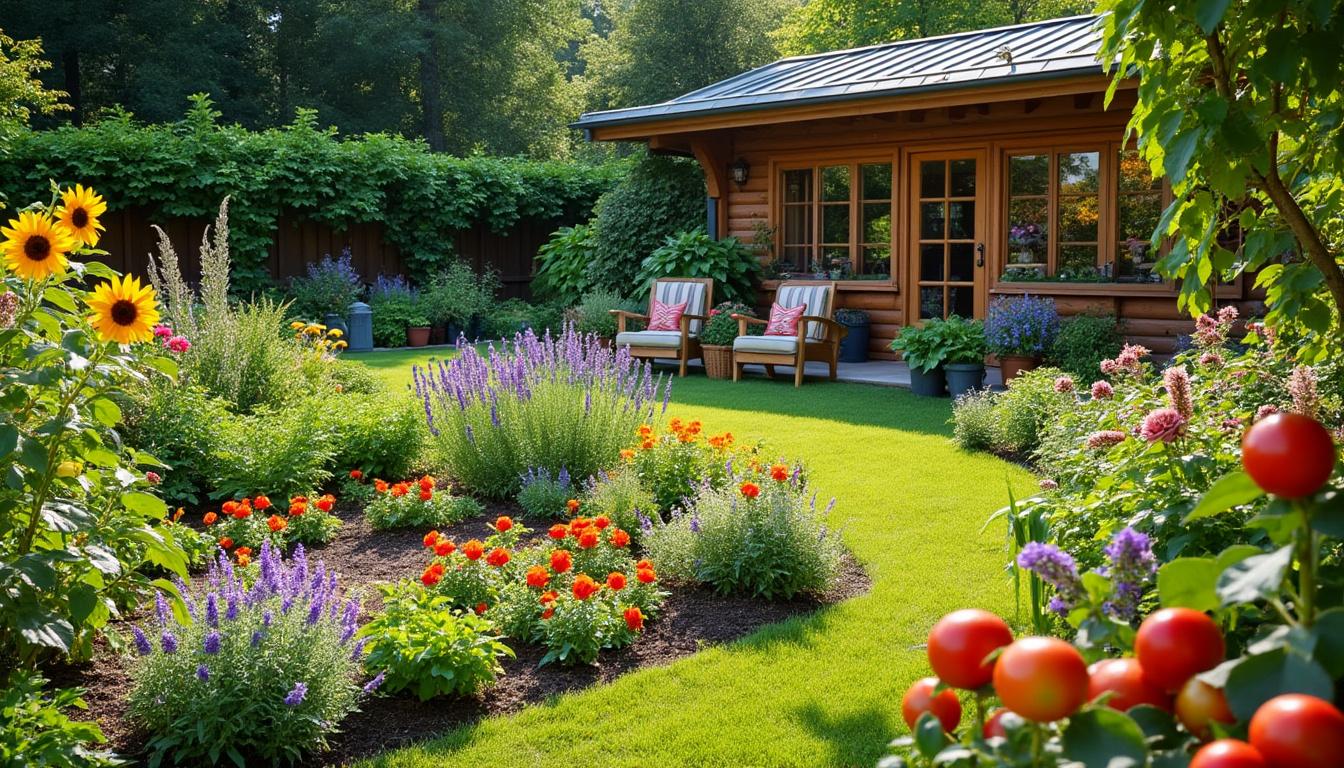Summer presents an unparalleled opportunity to transform outdoor spaces into vibrant sanctuaries teeming with life and color. As temperatures climb and days stretch longer, gardeners face the dual challenge of harnessing the blazing sunshine while nurturing delicate plants to their fullest glory. Chalet Home & Garden stands at the forefront, guiding enthusiasts with expert insights to ensure every garden flourishes amid the summer heat. This comprehensive exploration delves deep into essential strategies, from choosing the right plants to mastering watering techniques, ultimately revealing the path to garden essentials that promise summer blooms in every corner of your backyard botanics.
Summer Garden Essentials: Mastering Plant Selection for Garden Glory
Choosing plants that will thrive under summer’s intense sun and variable conditions is crucial for any gardener aiming to maximize their garden’s potential. Heat-loving perennials such as coneflowers, black-eyed Susans, and daylilies have proven their resilience and ability to brighten any landscape with relentless summer blooms. These sunshine plants not only offer vibrant colors but also sustain prolonged periods of growth with minimal maintenance, making them indispensable components of a summer garden.
Alongside these perennial favorites, shrubs like hydrangeas and butterfly bushes contribute both structure and attract pollinators essential for ecological balance. These summer staples flourish when planted mid-season, courtesy of warm soil temperatures and more stable weather conditions—a fact championed by garden experts at Chalet Home & Garden. This timing advantage supports rapid root establishment and robust growth, defying the common misconception that summer planting is ill-advised due to heat stress.
To further enhance plant health and vibrancy, consider the following strategies:
- Assess soil quality: Regularly test and amend soil with organic compost to maintain nutrient balance.
- Choose drought-tolerant varieties: Plants adapted to withstand intermittent dryness reduce water dependency and improve sustainability.
- Optimize plant spacing: Allow adequate airflow and light penetration to deter disease and promote strong stems.
- Incorporate companion planting: Pair plants like marigolds with vegetables to naturally repel pests and enhance growth.
- Apply mulch layers: Retain soil moisture and suppress weeds for consistent plant wellbeing.
Complement these approaches with insights from regional planting guides to tailor your garden according to local climate nuances, such as those offered by resources like Daily Bakersfield News. This ensures the right fit for your garden and maximizes the chances of robust growth and garden glory.
| Plant Type | Optimal Planting Period | Water Requirements | Sunlight Preference | Notable Benefits |
|---|---|---|---|---|
| Coneflowers | Mid-July to August | Moderate; drought-tolerant | Full sun | Attract pollinators; vibrant summer blooms |
| Black-eyed Susans | Mid-July to August | Low to moderate | Full sun | Disease-resistant; long bloom period |
| Hydrangeas | Late summer plantings | High; requires consistent moisture | Partial to full sun | Provides structural beauty; supports pollinators |
| Butterfly Bushes | Mid-summer | Moderate | Full sun | Attracts butterflies and hummingbirds |
| Daylilies | Mid-summer to early fall | Low | Full sun | Low maintenance; vibrant colors |
Plant Perfect Watering Techniques to Beat the Summer Heat
Water management remains one of the most pivotal garden essentials during summer. The scorching sun and dry air can quickly stress plants, leading to wilting and reduced flowering. Chalet Home & Garden offers innovative watering methods designed to optimize hydration without waste, ensuring plants absorb and retain moisture effectively. Among the recommended strategies is the “4-quadrant count-to-5” approach where gardeners water four distinct sections of their garden for a five-second count to evenly saturate the soil and avoid runoff.
Timing watering schedules to early mornings takes advantage of cooler temperatures and reduced evaporation rates, enabling plants to absorb moisture deeply. Evening watering, while common, risks fungal diseases due to prolonged leaf dampness. Additionally, installing drip irrigation systems or soaker hoses provides controlled hydration directly to roots, limiting moisture loss and conserving water—aligning well with growing trends in sustainable gardening and green technologies.
Other vital watering tips include:
- Monitor soil moisture: Use moisture meters or simple finger tests to avoid over- or under-watering.
- Avoid wetting foliage: Direct watering at the soil level minimizes disease risk.
- Adjust watering volume: Account for rainfall and heat spikes to tailor irrigation volumes.
- Incorporate mulch: Helps maintain consistent soil moisture and reduces watering frequency.
- Collect rainwater: Utilize barrels to harness natural precipitation, promoting eco-friendly practices.
For enthusiasts in varying climates, consulting detailed guides such as regional watering protocols can further optimize practices tailored to local conditions.
| Watering Method | Advantages | Best Used For | Considerations |
|---|---|---|---|
| Early Morning Watering | Maximizes absorption; reduces evaporation | Most outdoor plants | Requires early schedule adherence |
| Drip Irrigation | Targets roots; conserves water | Vegetables, shrubs, flower beds | Installation cost and maintenance |
| Soaker Hoses | Uniform watering; easy to install | Garden beds and borders | Potential clogging; seasonal removal |
| Hand Watering | Control over amount; reduces waste | Newly planted or sensitive species | Time-consuming for large gardens |
| Rainwater Collection | Eco-friendly; reduces water bills | All plant types | Dependence on rainfall; storage needs |
Grow Green: Sustainable Practices For Flourish & Bloom During Summertime
Embracing sustainability in summer gardening practices is not merely a trend but a necessary evolution that ensures the longevity and vitality of backyard botanics. Chalet Home & Garden advocates for green gardening techniques that minimize environmental impact while maximizing garden productivity and garden innovations. This approach encourages the use of organic fertilizers, integrated pest management, and native plants adapted to local ecologies.
Organic composting enriches soil structure and nutrition, fueling plant growth without synthetic chemicals. Another keystone of sustainable gardening lies in fostering biodiversity through pollinator-friendly choices such as planting shade-tolerant perennials alongside sunshine plants. These combinations support a variety of pollinators including bees, hummingbirds, and butterflies, pivotal for continued flowering and seed setting.
Practical steps to cultivate a green garden include:
- Use native plants: Reduce water and fertilizer demands, and boost local ecosystems.
- Implement integrated pest management (IPM): Employ natural predators and minimal chemical interventions.
- Practice crop rotation and interplanting: Keeps soil healthy and reduces pest cycles.
- Conserve water with mulching and drought-resistant species: Supports flourish & bloom through dry spells.
- Utilize compost tea and natural soil amendments: Promote microbial health and nutrient availability.
Exploring detailed resources about green drenching techniques and sustainable summer garden care such as this guide offers in-depth insights for dedicated growers committed to ecological stewardship.
| Sustainable Practice | Benefits | Recommended For | Potential Challenges |
|---|---|---|---|
| Organic Composting | Improves soil fertility; reduces chemical reliance | All garden types | Requires time and management |
| IPM | Reduces pest damage; environmental safety | Fruit, vegetables, ornamentals | Needs knowledge of pest cycles |
| Native Plant Use | Adapted to local conditions; resource efficient | Water-wise and restorative gardens | Selection limitations in some regions |
| Mulching | Preserves moisture; suppresses weeds | All plant beds | Needs periodic replenishment |
| Companion Planting | Enhances growth; deters pests | Mixed vegetable and flower gardens | Requires planning and knowledge |
Backyard Botanics: Designing Your Space for Maximum Summer Blooms
Strategic garden design forms a bedrock for vibrant summer blooms and long-term garden success. Providing the right conditions and configurations accelerates plant growth and decorative appeal. Chalet Home & Garden’s design philosophy incorporates layering, color themes, and functional planting to create captivating and productive outdoor living environments.
Key principles of effective design include:
- Layer planting: Arrange tall, medium, and low-height plants to maximize space and visual impact.
- Utilize color blocking: Group plants by color families to generate bold statements and harmonious transitions.
- Incorporate pollinator-friendly zones: Designated areas for hummingbirds, bees, and butterflies encourage natural pollination and garden vitality.
- Feature seasonal succession planting: Stagger blooms to maintain continuous flower display throughout the season.
- Create comfortable pathways and seating areas: Enhance usability and enjoyment in garden glory.
Implementation examples include placing sun-loving plants such as daylilies and coneflowers in the brightest sections while shading sensitive shrubs with taller counterparts. Consider festive grouping of black-eyed Susans alongside purple coneflowers to captivate attention and invite pollinators. Incorporating water features or rain gardens can enhance microclimates and support sustainable water use.
Professional advice and regional design ideas can be accessed via expert platforms like Daily Bakersfield’s Oxford Farm gardening tips for tailored inspiration and practical application.
| Design Element | Description | Benefits | Example Plants |
|---|---|---|---|
| Layer Planting | Organizing plants by height in terraces or groups | Maximizes space and aesthetics | Coneflowers, shrubs, groundcovers |
| Color Blocking | Cluster plants by similar colors | Creates visual harmony and impact | Black-eyed Susans, lavender, daylilies |
| Pollinator Zones | Dedicated areas planting pollinator favorites | Enhances pollination and biodiversity | Butterfly bushes, milkweed, bee balm |
| Succession Planting | Stagger planting dates for continuous bloom | Maintains garden interest all summer | Zinnias, marigolds, snapdragons |
| Functional Spaces | Paths, seating, and water features incorporated | Boosts garden enjoyment and usability | Herbs, ornamental grasses, lilies |
Garden Innovations: Leveraging Technology and Expertise for Summer Success
Technological advancements combined with expert knowledge have redefined the potential of summer gardening. Chalet Home & Garden emphasizes the integration of innovative tools and scientific methods that empower gardeners to monitor and optimize their gardens remotely. Smart irrigation systems, soil sensors, and AI-driven plant health diagnostics provide data-driven insights allowing precise adjustments to watering, fertilizing, and pest control.
Furthermore, weekly events and lectures hosted by Chalet Home & Garden, such as their popular July 27 seminar on hummingbirds and pollinators, create invaluable learning platforms for gardeners aiming to elevate their garden’s ecological interplay. Engaging with community initiatives also supports sharing of garden passion and enrichment of lives through collective knowledge and mutual inspiration.
Essential innovations and best practices include:
- Smart irrigation controllers: Automate watering schedules based on weather forecasts and soil data.
- Digital soil monitors: Track moisture, pH, and nutrient availability in real-time.
- Mobile gardening apps: Provide tailored planting advice and pest alerts.
- Pollinator tracking technologies: Analyze pollination patterns to enhance plant reproduction.
- Community workshops and field visits: Access expert knowledge and socialize with fellow gardeners.
Interested gardeners can explore more insights and updates on gardening breakthroughs at Daily Bakersfield’s Garden Passion section, affirming the role of technology and shared expertise in cultivating garden glory.
| Innovation | Functionality | Benefit | Implementation Example |
|---|---|---|---|
| Smart Irrigation Controllers | Automate watering based on weather and soil | Water efficiency and convenience | Home garden and commercial landscapes |
| Soil Sensors | Measure moisture, acidity, nutrients | Precise soil management | Vegetable beds and flower gardens |
| Mobile Apps | Provide alerts and tailored advice | Improved decision-making | Smartphone-based monitoring |
| Pollinator Tracking | Analysis of pollination activity | Optimized plant reproduction | Research and hobby gardens |
| Community Events | Workshops and lectures | Knowledge sharing and networking | Chalet Home & Garden weekly programs |
FAQ: Essential Questions About Maximizing Your Summer Garden
- When is the best time to plant heat-loving perennials in summer?
Mid to late July is ideal, as warm soil and consistent weather facilitate strong root establishment and growth. - What watering methods best conserve water during hot months?
Early morning watering combined with drip irrigation and mulch application optimizes moisture retention and reduces waste. - How can I make my garden more sustainable this summer?
Incorporate native plants, organic composting, integrated pest management, and water-conserving practices such as mulching. - What design strategies promote continuous summer blooms?
Layer planting, color blocking, pollinator zones, and succession planting ensure visual interest and ecological balance through the season. - How does technology enhance summer gardening success?
Tools like smart irrigation controllers and soil sensors provide data-driven care adjustments, improving efficiency and plant health.

